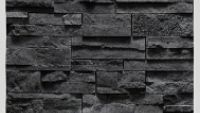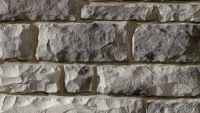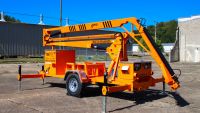Improving the Industry, One Innovation at a Time
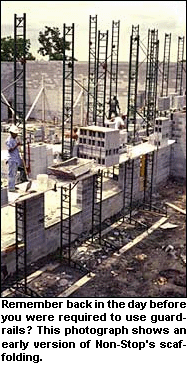 For years, there's been talk of making the masonry industry more competitive with other building systems ? making the #1 building system the #1 choice overall in consumers' and designers' minds. But for a building system that has been relatively unchanged since its creation, how do you go about doing that? Sometimes the best changes aren't made by leaps and bounds, but through one step at a time.
For years, there's been talk of making the masonry industry more competitive with other building systems ? making the #1 building system the #1 choice overall in consumers' and designers' minds. But for a building system that has been relatively unchanged since its creation, how do you go about doing that? Sometimes the best changes aren't made by leaps and bounds, but through one step at a time.
Although there are many solutions to making the masonry industry more competitive with other building systems, many masons and mason contractors are letting ingenuity guide the way.
In almost 30 years, the U.S. Patent and Trademark Office has granted 5,564 patents for various masonry inventions. From epoxies and texturing processes using cutting edge technologies, to newfangled stone-working tools, saws and masonry units, an average of 185 inventions are created for the masonry trade every year.
The following mason inventors have discovered faster, safer and less laborious ways of building masonry projects ? major keys to making the industry more competitive.
Genius is 10% Inspiration and 90% Perspiration
Justin Breithaupt, Sr., founder of Non-Stop Scaffolding, Inc., in Shreveport, La., first realized that he could improve efficiency while working on a 50-unit, one-story retirement village, one of his earliest masonry projects.
"About two-thirds of the way through it, one of my bricklayers brought out some new corner poles that he said would speed us up because we wouldn't have to build leads anymore," recalls Breithaupt. "Boy, he wasn't kidding! We put in about 30% more brick every day until we finished the job."
After finishing the project, he sat down and figured out that if he had been using corner poles at the beginning of the project, he would have made $6,000 more ? which was a lot of money in 1959.
"Ever since I learned about corner poles ? and I never built another wall without them ? I was always looking for ways to speed up my bricklayers," says Breithaupt. "One day I was watching them work and everybody stopped for about 20 minutes to hop planks and raise outriggers. Then it dawned on me that they might do that two or three times a day. Now, I don't make money unless they are laying bricks, and I saw where they were idle for 40 or 60 minutes a day, so I knew I had to figure out a way to recapture that downtime. That's where the scaffold came in."
After trying out elevating scaffolding, which were new on the market at the time, he discovered how much he could save in labor. A 100-day job turned into an 80-day job. Unfortunately, his crew hated the scaffolding ? it was difficult to use and didn't provide a stable working environment.
"I knew I couldn't be without elevating scaffolding, but the systems on the market weren't the answer," Breithaupt says. "That's when I set out to design my own."
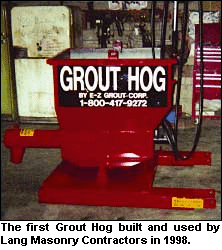 The stories of other mason inventors follow a similar lead.
The stories of other mason inventors follow a similar lead.
Damian Lang, Owner of Lang Masonry Contractors, Inc., and EZ Grout Corporation of Waterford, Ohio, learned early on the importance of using the right equipment for the job. After enduring the back-aching task of grouting walls with five-gallon buckets and the frustration of working with a grout pump that kept plugging up, the unexpected products of EZ Grout began to formulate.
"It took 10 years to create the Grout Hog," he says. "The reason it took so long was because I wasn't intending to invent anything. All I knew was that there had to be a better way to grout masonry walls. So I kept experimenting by building different types of buckets and trying them when we were grouting. I must have made at least 100 changes over the 10-year period before finishing the machine."
For all of the inventors we spoke to, necessity was definitely the mother of invention.
Tony Goudreau and Elio Stocchetti, masons for Local #2 N.Y. and inventors for E-Z Rod Enterprises of Scotia, N.Y., have introduced a new device that lines up control joints more accurately.
"We were doing a $16 million New York State Department of Transportation building in Schenectady, N.Y.," Goudreau says. "Maintaining our control joints was critical because of the way the windows were laid out. So we just wanted to come up with a fast and simple way where we didn't have to worry about masons hitting their marks. We could just set up these simple brackets that had the E-Z Rod incorporated with them. Then you just had to butt your brick to the steel rod. And it really worked out rather well.
"We decided to look into producing it when we heard from a few other masons on the job that they really enjoyed working with the E-Z Rod Control Joint System," he continues. "It just makes the job that much easier."
The Safety Factor
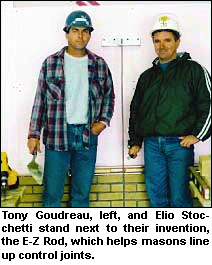 Making the job faster, easier and better aren't the only reasons for creating an invention.
Making the job faster, easier and better aren't the only reasons for creating an invention.
Mark Stutler, Owner of R&S Wall Systems in Hurricane, W.Va., recently introduced his masonry invention, the Wal-Kap, to the market. This product makes the old way of putting plastic over the walls to keep the water out during construction a thing of the past.
"What happens is when you put that block on top of the wall to hold that plastic and you have that plastic draped over, the wind blows and it starts tugging," says Stutler. "It creates an umbrella effect and, before you know it, that block is being pulled off of the wall. We've had block fall off of the wall and almost hit people in the head."
Not with the Wal-Kap, though.
"One person can assemble the Wal-Kap and follow behind the block layers and protect the walls as work is still in progress," Stutler says.
Since most of these inventors are also masons and mason contractors, you have the added bonus of knowing that they wouldn't build a wall with anything less than the best.
"When we started selling our scaffolding to other contractors, we didn't change the specs one bit," Breithaupt states. "You see, when I made it for myself, I made it a lot tougher than my engineer said was necessary. That gives it great bang-around resistance. That's why we can give a lifetime warranty.
"We designed the tower right the first time ? no Non-Stop has ever collapsed in use, ever. I'm really proud of that," he continues. "We also work closely with OSHA to make sure it's completely safe. If you keep your guardrails up, OSHA citations are pretty much a thing of the past."
Lessening Labor
Mike Gresser, President of Gresser Company, Inc., and Co-founder of ReCon Wall Systems, Inc., of South Eagan, Minn., has taken masonry to a whole different level.
Gresser and Co-founder Matt Barron sketched out a way to create a less laborious way to build large-scale retaining walls ? thus ReCon Wall Systems, Inc., was born. Weighing in at almost a ton each, the blocks are placed in half the time with the use of machinery and are almost half the cost of using poured concrete. Plus the ReCon blocks can be shaped, stained and textured to resemble natural stone.
"When I look at what's happened out there, particularly the advent of tower scaffolding systems becoming so much more efficient, and water infiltration preventers and mortar systems becoming more advanced, it's all helping but it still comes down to the fact that masonry is a very labor-intensive business," Gresser says. "If we can't control the cost of labor and keep an efficient source of labor coming, in the long-term it will make it difficult for masonry to be competitive.
"What our product does is it lacks the labor intensity of other engineered retaining wall products. They're laid by hand, and ours are laid by machinery."
"Being a mason contractor, it's all about efficiency," states Gresser. "It's all about going and winning the work and performing it efficiently and safely."
Stuck in the Routine
One hurdle to overcome with new inventions for the industry is that masons are used to doing things the "old fashioned" way.
"Any time you introduce a new product to the marketplace, even if it's an improved product to a product that's already out there, you have those people out there who are stuck in their ways," says Stutler. "Even though it's better, you get the 'this is what I've always done and I'm going to continue to do it this way' mentality.
"It's our mission to change the industry standard in masonry wall construction. It's something that is going to require a little bit of time, but we'll get there."
Lang not only shows that his new products are better in the field, but also on mason contractors' bottom lines.
"In order to sell a new product, you must prove that the product will save or make others money," Lang simply states.
Listening to the Customers' Needs
The inventors aren't the only ones moving this industry forward.
"There are a lot of contractors out there who have tremendous ideas, if only the manufacturer would listen to them," says Lang. "Wayne Long with L.F. Jennings suggested the idea to build the Hog Cart. Harold Trogdon with Trogdon Masonry, Eric Reihl with Corna Kokosing and others who attended my seminars sparked ideas to help me create the Hog Legs for bracing masonry walls. Dennis Knowlton with Knowlton Construction offered feedback when I was developing the Mud Hog.
"Most manufacturers build products the way they want to build them themselves," he continues. "We like to build EZ Grout products the way our users want them built."
Goudreau uses a similar philosophy to create a better product.
"I'm waiting to hear back from some people who purchased the E-Z Rod at one of the shows," says Goudreau. "I'm getting ready to follow up on that to see how they liked them and how it's been working for them."
Conclusion
The bottom line is that these products, big and small, are being created to put more money in the mason contractors' pockets, make it safer for the masons and other laborers, and overall to make the industry more viable.
"It's a great feeling really," says Breithaupt. "I know that contractor is making better money than he or she did on frames, and that the job is going a lot smoother. I know that bricklayer on the scaffold will go home without a sore back because it's so much more comfortable for him or her. I think it also contributes to the professionalism of the mason contractor in the eyes of the architect and the general contractor.
"I think our products have made a positive contribution to the masonry industry, and I'm really happy about that."
About the Author
Jennie Farnsworth is an Atlanta-based freelance writer and editor. She is a former editor of Masonry magazine.












